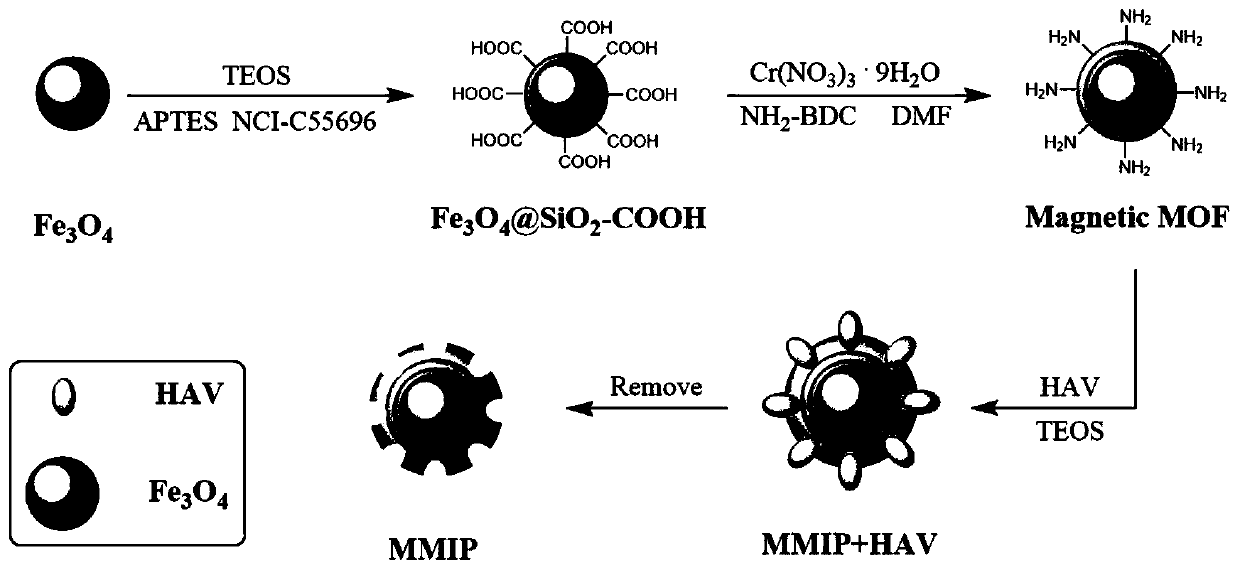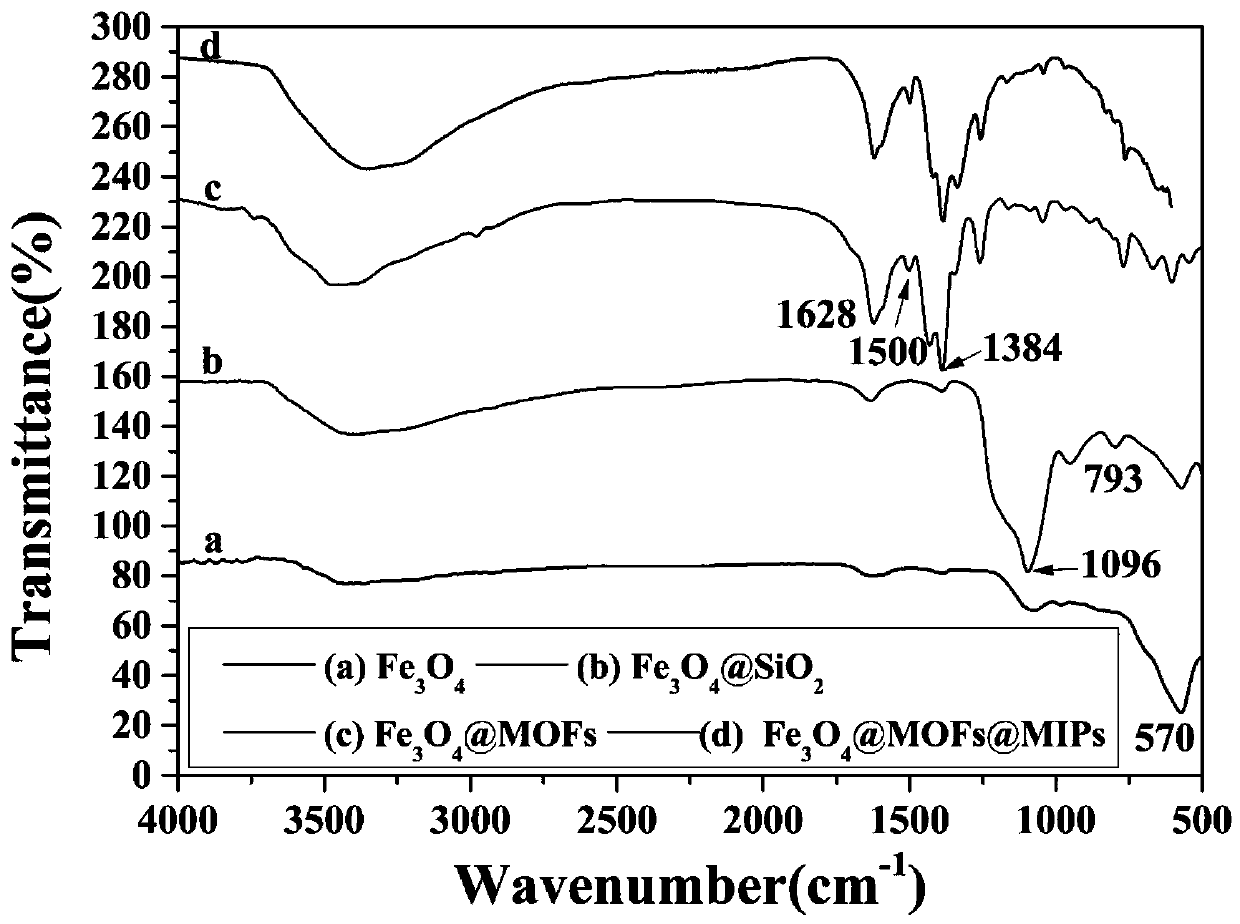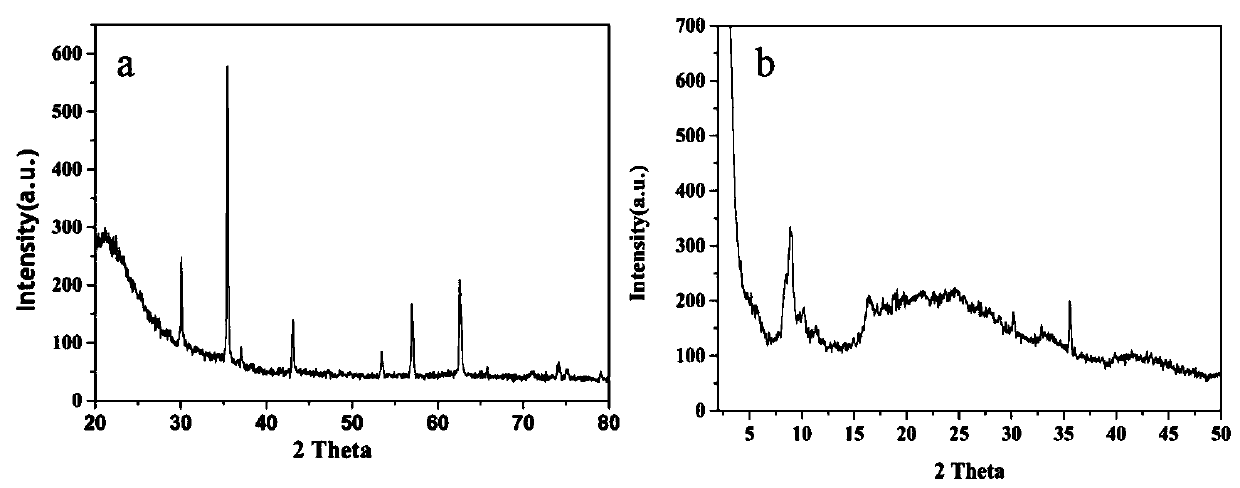Construction and application of novel fluorescent imprinting sensor based on magnetic metal organic framework (MOF)
A fluorescence sensor and organic framework technology, applied in the field of analytical chemical detection, can solve the problems of unsatisfactory detection range and detection limit, unstable fluorescence, weak fluorescence intensity, etc., achieving satisfactory imprinting effect, simple preparation process, and easy retouching effect
- Summary
- Abstract
- Description
- Claims
- Application Information
AI Technical Summary
Problems solved by technology
Method used
Image
Examples
Embodiment 1
[0025] Example 1: Preparation method of a novel virus fluorescent molecular imprinting sensor
[0026] (1) Fe 3 o 4 @MIL-101-NH 2 Synthesis of: First, prepare carboxy-functionalized Fe3O4 particles, 1gFe 3 o 4 , 100mL of isopropanol, 4mL of ultrapure water, ultrasonic treatment for 20min after uniform dispersion. Under mechanical stirring, 20 mL of ammonia water was added, 6 mL of TEOS was added dropwise, and the reaction was carried out in an oil bath at 45° C. for 6 h. Finally washed with distilled water, ethanol, and dried under vacuum at 60 °C to obtain Fe 3 o 4 @SiO 2 The product is ready for use. Dissolve 0.5g of succinic anhydride (SA) and 1mL of 3-aminopropyltriethoxysilane (APTES) in 30mL of acetic acid, sonicate for 5min, and stir at 30°C for 3h. Then add 40mg Fe 3 o 4 @SiO 2 Particles, 20mL acetic acid and 3mL ultrapure water, and the mixture was ultrasonically dispersed and reacted extensively in an oil bath at 30°C for 12h. After washing with water, i...
Embodiment 2
[0030] Example 2: Characterization of the performance, morphology and structure of the MMIPs fluorescent sensor and intermediate products.
[0031] The structure and morphology of all the prepared materials were characterized by Fourier transform infrared spectrometer, X-ray diffractometer and scanning electron microscope. figure 2 for Fe 3 o 4 (a), Fe 3 o 4 @SiO 2 (b), Fe 3 o 4 @MOFs(c) and Fe 3 o 4 Infrared spectra of @MOFs@MIPs(d) particles. about 570cm -1 The absorption peak at is attributed to Fe 3 o 4 Fe-O characteristic peaks. 1096cm -1 The absorption peak at is the stretching vibration peak of Si-O-Si, 793cm -1 The absorption peak at is the vibrational peak of Si-O. This is Fe 3 o 4 @SiO 2 The synthesis provides evidence. The resulting lines all contain these characteristic peaks. After synthesizing the MOF, the infrared spectrum changed again. 1384cm -1 ,1500cm -1 and 1628cm -1 The three absorption peaks represent the Fe 3 o 4 MIL-101-NH for...
Embodiment 3
[0034] Example 3: Application of the fluorescent molecularly imprinted sensor
[0035] The experimental conditions of this example are: the dosage of MMIPs is 22.44 mg / mL, the pH is 7.5, the adsorption time is 15 min, and the temperature is 37°C. The specific embodiment is: take specific concentration of HAV and MMIP in 19 μg / mL PB buffer, adjust the pH of the whole system to 7.5, and measure the fluorescence intensity after shaking and adsorbing at 37° C. for 15 minutes.
[0036] (1) Detection and analysis of different concentrations of HAV by MMIPs fluorescent sensor
[0037] Under the optimal experimental environment, the linear relationship between fluorescence intensity and template virus concentration was studied. Such as Figure 5 As shown, when the template virus concentration is in the range of 20pM-2500pM, the fluorescence intensity has a good linear relationship with the template virus concentration. The linear regression equation is y=251.53x+175.92, R 2 =0.997...
PUM
| Property | Measurement | Unit |
|---|---|---|
| Particle size | aaaaa | aaaaa |
Abstract
Description
Claims
Application Information
 Login to View More
Login to View More - R&D
- Intellectual Property
- Life Sciences
- Materials
- Tech Scout
- Unparalleled Data Quality
- Higher Quality Content
- 60% Fewer Hallucinations
Browse by: Latest US Patents, China's latest patents, Technical Efficacy Thesaurus, Application Domain, Technology Topic, Popular Technical Reports.
© 2025 PatSnap. All rights reserved.Legal|Privacy policy|Modern Slavery Act Transparency Statement|Sitemap|About US| Contact US: help@patsnap.com



